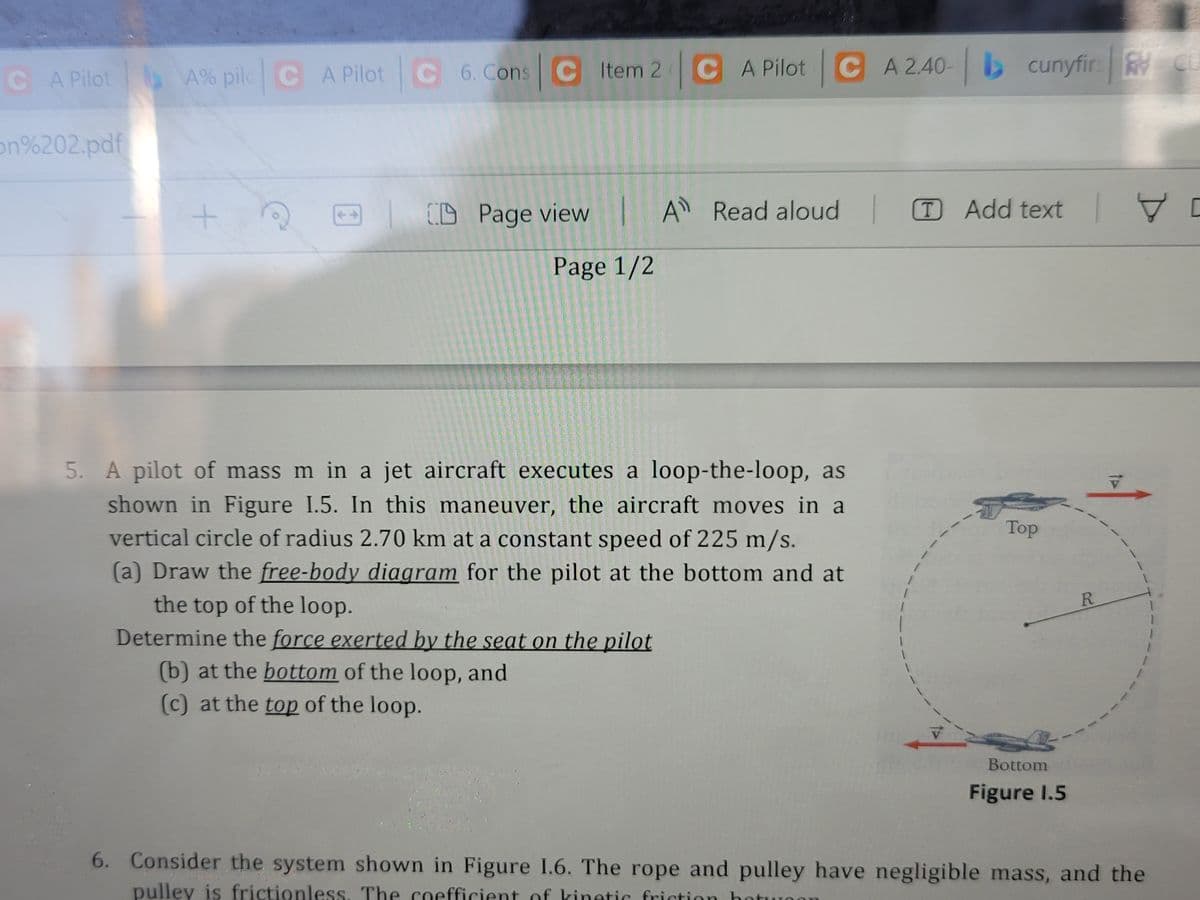A pilot of mass m in a jet aircraft executes a loop-the-loop, as shown in Figure I.5. In this maneuver, the aircraft moves in a vertical circle of radius 2.70 km at a constant speed of 225 m/s. (a) Draw the free-body diagram for the pilot at the bottom and at Top the top of the loop. R. Determine the force exerted by the seat on the pilot (b) at the bottom of the loop, and (c) at the top of the loop. Bottom Figure I.5
A pilot of mass m in a jet aircraft executes a loop-the-loop, as shown in Figure I.5. In this maneuver, the aircraft moves in a vertical circle of radius 2.70 km at a constant speed of 225 m/s. (a) Draw the free-body diagram for the pilot at the bottom and at Top the top of the loop. R. Determine the force exerted by the seat on the pilot (b) at the bottom of the loop, and (c) at the top of the loop. Bottom Figure I.5
Principles of Physics: A Calculus-Based Text
5th Edition
ISBN:9781133104261
Author:Raymond A. Serway, John W. Jewett
Publisher:Raymond A. Serway, John W. Jewett
Chapter5: More Applications Of Newton’s Laws
Section: Chapter Questions
Problem 18P: Why is the following situation impossible? The object of mass m = 4.00 kg in Figure P5.18 is...
Related questions
Question
please step bt step

Transcribed Image Text:CA Pilot
A% pilc CA Pilot C 6. Cons C Item 2 C A Pilot CA 2.40- b
on%202.pdf
CD Page view
A Read aloud
T Add text
7 D
Page 1/2
5. A pilot of mass m in a jet aircraft executes a loop-the-loop, as
shown in Figure I.5. In this maneuver, the aircraft moves in a
vertical circle of radius 2.70 km at a constant speed of 225 m/s.
Top
(a) Draw the free-body diagram for the pilot at the bottom and at
R.
the top of the loop.
Determine the force exerted by the seat on the pilot
(b) at the bottom of the loop, and
(c) at the top of the loop.
Bottom
Figure I.5
6. Consider the system shown in Figure I.6. The rope and pulley have negligible mass, and the
pulley is frictionless, The coefficient of kinetic friction hot
Expert Solution
This question has been solved!
Explore an expertly crafted, step-by-step solution for a thorough understanding of key concepts.
This is a popular solution!
Trending now
This is a popular solution!
Step by step
Solved in 3 steps with 3 images

Knowledge Booster
Learn more about
Need a deep-dive on the concept behind this application? Look no further. Learn more about this topic, physics and related others by exploring similar questions and additional content below.Recommended textbooks for you

Principles of Physics: A Calculus-Based Text
Physics
ISBN:
9781133104261
Author:
Raymond A. Serway, John W. Jewett
Publisher:
Cengage Learning

University Physics Volume 1
Physics
ISBN:
9781938168277
Author:
William Moebs, Samuel J. Ling, Jeff Sanny
Publisher:
OpenStax - Rice University

Glencoe Physics: Principles and Problems, Student…
Physics
ISBN:
9780078807213
Author:
Paul W. Zitzewitz
Publisher:
Glencoe/McGraw-Hill

Principles of Physics: A Calculus-Based Text
Physics
ISBN:
9781133104261
Author:
Raymond A. Serway, John W. Jewett
Publisher:
Cengage Learning

University Physics Volume 1
Physics
ISBN:
9781938168277
Author:
William Moebs, Samuel J. Ling, Jeff Sanny
Publisher:
OpenStax - Rice University

Glencoe Physics: Principles and Problems, Student…
Physics
ISBN:
9780078807213
Author:
Paul W. Zitzewitz
Publisher:
Glencoe/McGraw-Hill

College Physics
Physics
ISBN:
9781285737027
Author:
Raymond A. Serway, Chris Vuille
Publisher:
Cengage Learning

Physics for Scientists and Engineers, Technology …
Physics
ISBN:
9781305116399
Author:
Raymond A. Serway, John W. Jewett
Publisher:
Cengage Learning

Physics for Scientists and Engineers: Foundations…
Physics
ISBN:
9781133939146
Author:
Katz, Debora M.
Publisher:
Cengage Learning